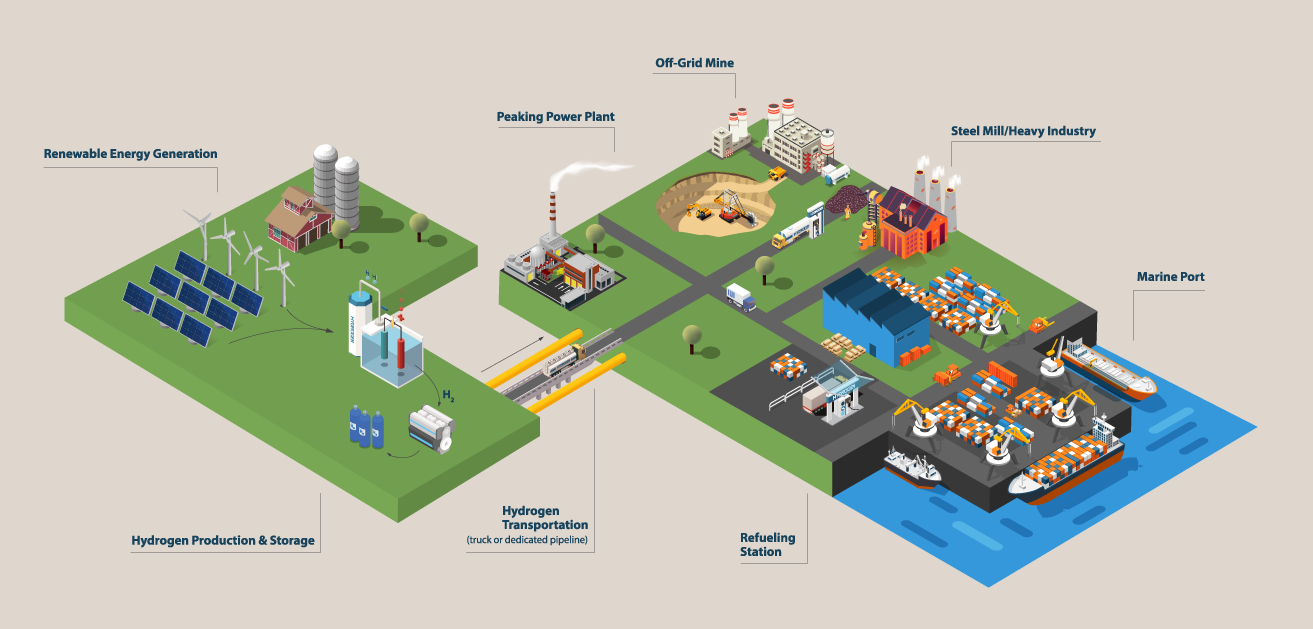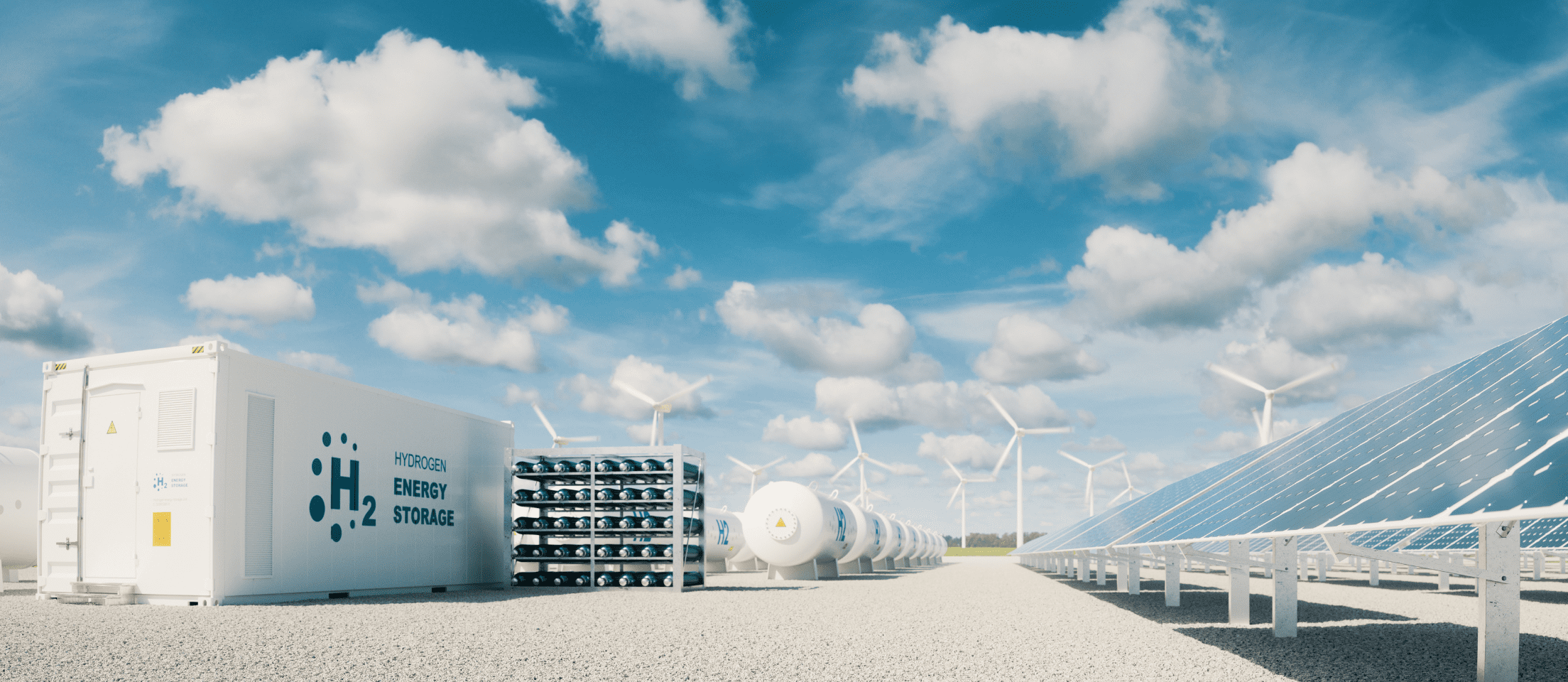Hydrogen is the lightest and most abundant element in the universe and accounts for about 75% of the mass of the visible universe. Today hydrogen is used in several industrial applications—from steel production to fertilizer production.
On Earth, this element is primarily found in water (H2O). While there are a few ways to extract H2 molecules, around 95% of hydrogen today is produced from fossil fuels via a process called steam methane reforming (SMR).
The most precise way to describe the different hydrogen production methods is to include their carbon intensity; however, traditionally different colors have been used as a shortcut or proxy for the different pathways. Extracting hydrogen via SMR is often referred to as gray hydrogen, which is the process of cracking hydrogen from methane (CH4) contributes about 3% of global greenhouse gas (GHG) emissions and has a carbon intensity of 70–90 kg CO2e/GJ H2.1 When emitted carbon from the SMR process is captured and stored, the hydrogen production method is referred to as blue hydrogen. The carbon intensity of blue hydrogen typically varies from10–50 kg CO2e/GJ H2depending on the technology used, carbon capture rate, and upstream GHG emissions associated with imported electricity and natural gas production.
Recently, cleaner ways to extract hydrogen have become more widely available. Green hydrogen is produced using an alternative production method that splits water into hydrogen and oxygen with renewable electricity via a process known as electrolysis. When electrolyzers are powered by renewable energy sources like solar photovoltaics or wind turbines, it produces virtually no GHG emissions.
While hydrogen is an important decarbonization tool, specific challenges are associated with using hydrogen instead of natural gas or methane. These include the higher cost of producing hydrogen, its lower energy density per unit volume, and the need for new infrastructure to store, transport, and utilize the molecule.2
NovoHydrogen addresses these challenges with a unique approach to onsite and near-site hydrogen development. For example, producing hydrogen onsite eliminates most midstream costs and enables delivery of a lower cost of hydrogen to the customer. Our customers can procure competitively priced green hydrogen by signing a long-term (typically 10–20 years) fixed price Hydrogen Purchase Agreement (HPA), which protects from the price volatility of other fuels like natural gas while securing a reliable energy source for their operations.

Furthermore, the declining cost and increasing efficiency of electrolyzers, coupled with lower-cost renewables and supportive economic incentives, are also helping to decrease production costs and increase hydrogen’s adoption.
Policy Tailwinds Supporting Clean Hydrogen Production
The U.S. government is supporting the production and consumption of green hydrogen through a series of favorable federal policies. These include the following:
- The U.S. Department of Energy (DOE)’s Energy Earthshot Initiative: The purpose of this program is to accelerate breakthroughs of more abundant, affordable, and reliable clean energy solutions. DOE announced a “Hydrogen Shot” goal in 2021, which seeks to bring the cost of clean hydrogen down to $1 per kilogram within one decade or by 2031.3
- H2Hubs Program: To increase the deployment of clean hydrogen projects across the country, the Infrastructure Investment and Jobs Act (IIJA) established a Regional Clean Hydrogen Hubs program4, which allocated up to $7 billion to establish 6–10 regional clean hydrogen hubs to demonstrate the production, processing, delivery, storage and end-use of clean hydrogen. IIJA also includes $1 billion for demonstration, commercialization, and deployment of electrolyzer systems, another $1 billion to support demand-side incentives for the H2Hubs Program, and $500 million to support a clean hydrogen domestic supply chain.5
- Tax Credits: The Inflation Reduction Act of 2022 (IRA), another important federal policy, provides a Production Tax Credit (PTC) that will award up to $3 per kg for low-carbon (less than 0.45 kg CO2e/kg H2) hydrogen production over ten years as well as an Investment Tax Credit (ITC), which can be taken in lieu of the PTC, to supplement expenses to construct the hydrogen production facility. Meeting additional standards, such as sourcing project materials from domestic sources6 and locating the project in an energy community7, act as credit enhancers and can boost the ITC or PTC amount.
In addition to federal support, several supplemental state-level programs are driving green hydrogen adoption. These include low-carbon fuel standards, clean energy standards, and industrial decarbonization mandates. Some notable ones include:
- California’s Low Carbon Fuel Standard (LCFS): The California LCFS requires transportation fuel producers to reduce the carbon intensity (CI) of their fuels 20% below 2010 levels by 2030 and fines entities producing fuels above that CI cap, while generating credits for entities below the cap to sell in a secondary market. California is considering increasing the requirement to a 30% reduction by 2030 and 90% reduction by 2045.8
- Washington’s Clean Energy Transformation Act (CETA): CETA commits Washington to an electricity supply free of GHG emissions. CETA requires electricity generators to produce 100% of electricity from carbon-free energy sources by 2045, with interim targets along the way.9
- Colorado’s Greenhouse Gas Emissions and Energy Management for Manufacturing (GEMM) Initiative: Colorado GEMM program requires facilities that emit 25,000 or more metric tons of GHGs per year to reduce their GHG emissions, cut emissions of co-pollutants, and submit a GHG reduction plan with the goal of helping the state reach its GHG emissions reduction goals.10
Together these types of legislation are supporting green hydrogen adoption to decarbonize the hard-to-abate transportation, power, and industrial sectors.
In the next article in this series, we will discuss which customers and industrial segments are in the best position to capitalize on the green hydrogen opportunity. If you are interested in learning more about how green hydrogen can be a solution for your facility, please get in touch with us at info@novohydrogen.com.
- Carbon Intensity of Blue Hydrogen | Pembina.org; Hydrogen production: Steam Methane Reforming (SMR) | Hydrogène ↩︎
- Hydrogen power is gaining momentum, but critics say it's neither efficient nor green enough ↩︎
- Hydrogen Shot | Department of Energy ↩︎
- Regional Clean Hydrogen Hubs | Department of Energy ↩︎
- Bipartisan Infrastructure Bill Clean Hydrogen Programs | Fuel Cell & Hydrogen Energy Association; Biden-Harris Administration to Jumpstart Clean Hydrogen Economy with New Initiative to Provide Market Certainty And Unlock Private Investment | Department of Energy ↩︎
- IRS provides initial guidance for the domestic content bonus credit | Internal Revenue Service ↩︎
- Energy Community Tax Credit Bonus - Energy Communities ↩︎
- Low Carbon Fuel Standard | California Air Resources Board ↩︎
- Clean Energy Transformation Act - Washington State Department of Commerce ↩︎
- Greenhouse Gas Emissions and Energy Management for Manufacturing in Colorado | Department of Public Health & Environment ↩︎

